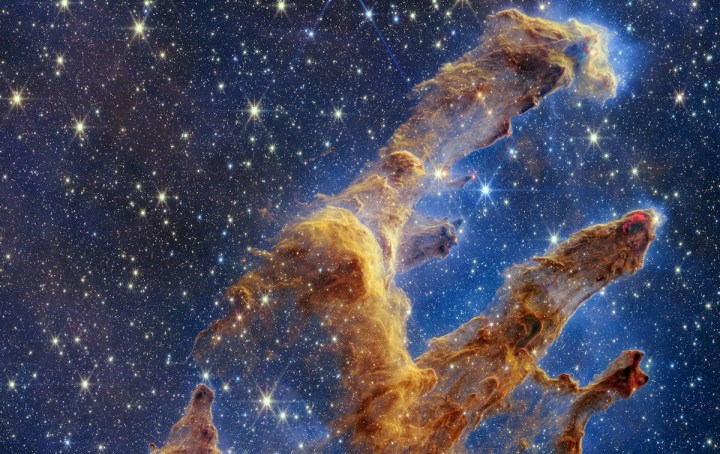Thanks to the James Webb Space Telescope, clumps of gas and dust have never looked so beautiful.
The latest awe-inspiring image, beamed to Earth by the most powerful space telescope ever built, shows in astonishing detail the Pillars of Creation some 6,500 light-years away.

Webb’s near-infrared image also shows the countless stars that formed within the dense clouds of gas and dust, as well as the youngest ones currently emerging from those clouds.
“The three-dimensional pillars look like majestic rock formations, but are far more permeable,” NASA said of the image. “These columns are made up of cool interstellar gas and dust that appear, at times, semi-transparent in near-infrared light.”
Captured by Webb’s Near-Infrared Camera (NIRCam), the image shows glowing red blobs at the end of some of the pillars, indicating areas where young stars are ejecting material as they form.
“When knots with sufficient mass form within the pillars of gas and dust, they begin to collapse under their own gravity, slowly heat up, and eventually form new stars,” NASA explained, adding that these new stars appear in Webb’s image as bright red orbs and are estimated to be only a few hundred thousand years old.
The Pillars of Creation gained widespread attention in 1995 when it was captured by NASA’s Hubble Space Telescope. Hubble imaged it again in 2014 — you can compare it with Webb’s effort below:

Webb’s image will enable researchers to update their models of star formation, the space agency said, helping us to learn more about how stars develop before they burst out of these dusty clouds over a period of millions of years.
After launching in December 2021, the Webb telescope is now in an orbit around a million miles from Earth as it peers toward deep space in a bid to learn more about the origins of the universe. Besides exploring areas of interest many light-years away, Webb is also taking time to image celestial bodies closer to home, with this image of Jupiter showing the planet as you’ve never seen it before.
Editors' Recommendations
- James Webb images capture the galactic winds of newborn stars
- See planets being born in new images from the Very Large Telescope
- This famous supernova remnant is hiding a secret
- James Webb snaps a stunning stellar nursery in a nearby satellite galaxy
- James Webb Space Telescope celebrated on new stamps


